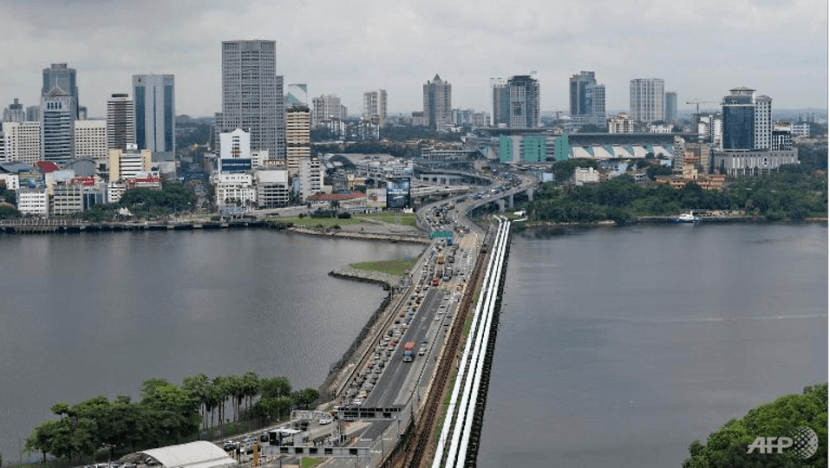Commentary: As Johor-Singapore SEZ plans accelerate, who stands to benefit?
Singapore has talent and technology; Johor has land and infrastructure, say UOB’s Lim Lay Wah and Tay Xiaohan of the planned Special Economic Zone.

A view of the Causeway that links Singapore to Malaysia's southern state of Johor. (Photo: AFP)

This audio is generated by an AI tool.
SINGAPORE: There has been much excitement about the proposed Johor-Singapore Special Economic Zone (SEZ) since a Memorandum of Understanding was signed between Singapore and Malaysia in January.
During his introductory trip to Malaysia on Wednesday (Jun 12), new Singapore Prime Minister Lawrence Wong highlighted the potential of the SEZ, saying that it could unlock massive economic benefits for both countries.
“People harp a lot on the competition (between our two economies), but really, we are complementing one another,” said Mr Wong.
His counterpart, Mr Anwar Ibrahim, said that plans for the zone are very close to being finalised.
Touted as a potential “Shenzhen of Southeast Asia”, details of the geographical scope of the SEZ in the southern Malaysian state are still being finalised, as are the specific economic sectors. A series of meetings are scheduled to take place this month between the Malaysia and Singapore working groups, which could provide more clarity. A full-fledged agreement is expected to be signed in September.
When Malaysia and Singapore announced plans to work on the SEZ, questions were raised as to the types of industries and sectors that would dominate and thrive in this new zone. Johor is proposing 16 economic sectors as part of the zone, including electrical and electronics, medical, aviation and manufacturing.
During a Johor state assembly sitting last month, chief minister Onn Hafiz Ghazi also said that the state government has proposed the zone span across six districts - Johor Bahru, Iskandar Puteri, Pasir Gudang, Pontian, Kulai and Kota Tinggi - encompassing a land mass of 3,505 sq km. This is more than four times the size of Singapore, and nearly double the size of Shenzhen.
Both Shenzhen and Johor have abundant natural resources and land, as well as access to a young and growing workforce. Both are also strategically located, being close to major economic hubs - Hong Kong in Shenzhen’s case, and Singapore for Johor. With key parallels between Johor and Shenzhen, and with the development of the SEZ, it is possible for Johor to emulate Shenzhen’s success in the near future.
CARVING A NICHE
Both Malaysia and Singapore are significant players and partners in the semiconductor ecosystem, and the SEZ will strengthen both countries’ position in the electrical and electronics sector.
In 2023, Malaysia’s electrical and electronics sector secured RM85.4 billion (US$18.1 billion) in approved investments, nearly three times the amount in 2022. Meanwhile, Singapore’s electronics cluster accounted for 24.2 per cent of the country’s total fixed asset investments at S$3.1 billion (US$2.3 billion) last year.
Additionally, with Penang already established as a semiconductor hub, the SEZ could further cement Malaysia's reputation as a leader in the electrical and electronics sector.
The World Economic Forum in April highlighted Malaysia’s emergence as a new semiconductor powerhouse, noting that major players from Europe and the United States are setting up shop or expanding existing operations in Penang to build new global supply chains.
Penang, dubbed the Silicon Valley of the East, has a strong electrical and electronics ecosystem with a longstanding presence in chip assembly, packaging and testing. However, it is not uncommon for skilled workers such as engineers to choose to pursue similar jobs in Singapore for better employment packages.
Last year, Malaysia’s then human resources minister V Sivakumar, said that as of 2022, 1.13 million out of 1.86 million Malaysians who migrated abroad were living in Singapore.
Once the SEZ is established, it could help to attract skilled talent to the hub, thus retaining talent within Malaysia. This can be supported by plans for a passport-free QR code clearance on both sides, facilitating faster clearance of people at land checkpoints.
As supply chains become more integrated between Singapore and Johor, Malaysia could retain and grow its talent pool, depending on how companies set up their operations within the SEZ.

A SEMICONDUCTOR HUB FOR THE REGION
Manufacturers seeking expansion opportunities in the region due to the ongoing geopolitical climate are likely to be attracted to the SEZ. This is likely to enhance its competitiveness against neighbouring countries like Thailand and Vietnam.
Singapore has leading companies carrying out R&D and wafer fabrication work in the country, while Malaysia plays a critical role in the assembly and testing of chips. With land scarcity and rising costs in Singapore, the SEZ allows talent from Singapore to travel quickly to Johor, facilitating the exchange of ideas and best practices. Marketing the hub will showcase Johor’s expanded capabilities, from backend assembly to packaging, testing and potential upstream activities.
Johor's robust infrastructure, including numerous large data centres, enhances its appeal. By mid-2024, Malaysia will host some of the world's fastest supercomputers, making it ideal for companies focusing on smart manufacturing and automation to optimise their processes.
Currently, the data centres are mostly in Nusajaya Tech Park, Sedenak Tech Park and YTL Green Data Centre Park. An artificial intelligence (AI) project between YTL Power and Nvidia will also be hosted at YTL’s data centre park in Kulai, Johor. This project, along with the entrance of key data centre players will be attractive to manufacturers looking to establish operations in Johor or the SEZ. Singapore also offers access to multiple subsea cable landing points that connect to the global network.
With the semiconductor industry racing to reduce its carbon footprint, a technology hub in the SEZ could potentially help alleviate some sustainability concerns. Companies can set up front-end fabrication facilities in Singapore, while having the assembly and testing of chips or logistics warehouse in Johor to reduce costs. The proximity between Singapore and Johor would also mean lower greenhouse gas emissions for a company’s carbon footprint.
A TWINNING MODEL
Singapore offers a strategic regional treasury centre, extensive R&D experience, and numerous free trade agreements, while Johor provides lower rental and wage costs, making production more competitive. The SEZ can promote this synergy to attract more companies to invest in both Singapore and Johor.
For example, semiconductor companies could set up a sales centre in Singapore, while keeping its warehouse in Johor to keep costs low. This twinning model will benefit the economic growth of both Johor and Singapore.
Johor has seen new investments due to its land, geographical location, connectivity and resources. It has also benefited from the supply chain diversification, as more companies have also set up bases in Johor. The SEZ will continue to propel this growth in Johor, and these companies that set up in Johor can also tap on the regional treasure centre opportunities in Singapore. This will also help further contribute to Singapore’s growth and development.
A one-stop business service centre will open later this year in Johor to facilitate the application processes for various approvals and licenses necessary for Singapore businesses to set up in Johor. This centre is the first of its kind and will see the collaboration of all federal and state agencies related to investments, benefiting companies looking to have a presence in the Southeast Asia region.
With the strengths of Singapore and Johor packaged together, both can use the SEZ and the existing ecosystem to draw investments into both regions.
Lim Lay Wah is Group Head, Global Financial Institutions Group & Sector Solutions Group, UOB. Tay Xiaohan is Head of Insights, Telecom, Media & Technology, Sector Solutions Group, UOB.





















